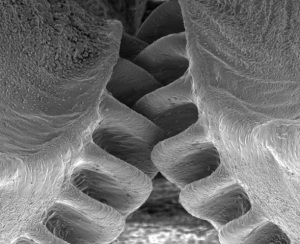Original Article from SPACE.com
——————————————————
On April 3, 2013, scientists announced results from their massive particle detector, the Alpha Magnetic Spectrometer (AMS), that had been surveying space from the International Space Station for over a year and a half.
The particle detector was designed to measure cosmic-ray particles in space. Over the course of 18 months, AMS detected billions of these particles. Finally, AMS picked up a signal that is likely to have originated from dark matter, which makes up over 75% of all matter in our universe. The signal AMS picked up came from about 400,000 positrons, or positively charged electrons. Even thought positrons are the anti-matter counterpart of an electron, scientists believe that these positrons may have been created when particles of dark matter collided with each other. However, dark matter is not the same as anti-matter.
An artists impression of dark matter in the universe. Source: Star Talk Radio
Dark matter emits no light, therefore it can’t be detected with telescopes. In addition, the amount of dark matter in the universe seems to significantly outweigh the amount of regular matter in the universe. Physicists believe that dark matter is made of weakly interacting massive particles (WIMPs), which seldom interact with regular matter. Because WIMPs are thought to annihilate each other, similar to dark matter, the reaction would leave behind a positron and an election. Scientists can links these positrons to dark matter because they match predictions for dark matter created positrons discovered by PAMELA. Positrons from dark matter should be found with energy levels higher than 10 GeV (gigaelectron volts). Not only were these particles discovered with energy levels above 10 GeV, some particles had energies of up to 250 GeV, lending further evidence to dark matter annihilations. Additionally, these positrons don’t come from a single source in the sky either, they originate from all over.
AMS has detected over 6.8 million positrons and electrons so far. Even though AMS will continue to collect data, scientists will not be able to tell if these come from dark matter or another source, despite the evidence. Another suggested theory is that these come from pulsars. In fact, scientists actually intend to learn more about dark matter at home, via underground experiments right here on Earth.












